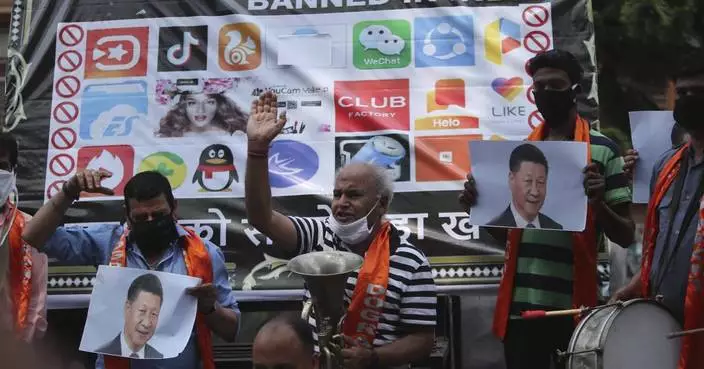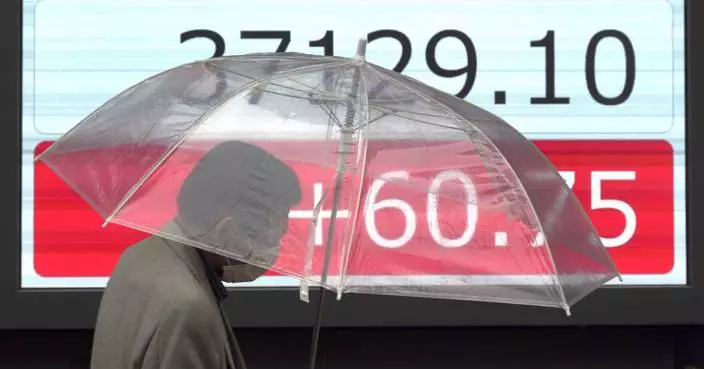China's defunct and reportedly out-of-control Tiangong 1 space station is expected to re-enter Earth's atmosphere sometime this weekend. It poses only a slight risk to people and property on the ground, since most of the bus-size, 8.5-ton vehicle is expected to burn up on re-entry, although space agencies don't know exactly when or where that will happen.
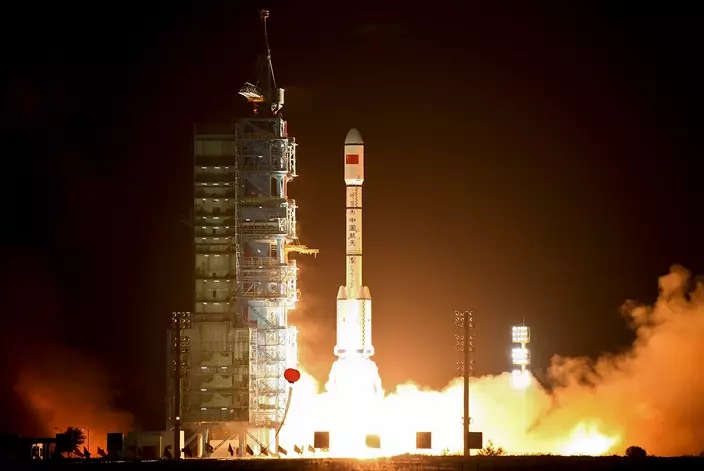
In this Sept. 29, 2011, file photo, a Long March-2FT1 carrier rocket loaded with China's Tiangong-1 space station blasts off from the launch pad at the Jiuquan Satellite Launch Center in northwest China's Gansu Province. (Color China Photo via AP, File)
Below are some questions and answers about the station, its re-entry and the past and future of China's ambitious space program.
Click to Gallery
China's defunct and reportedly out-of-control Tiangong 1 space station is expected to re-enter Earth's atmosphere sometime this weekend. It poses only a slight risk to people and property on the ground, since most of the bus-size, 8.5-ton vehicle is expected to burn up on re-entry, although space agencies don't know exactly when or where that will happen.
Below are some questions and answers about the station, its re-entry and the past and future of China's ambitious space program.
Western space experts say they believe China has lost control of the station. China's chief space laboratory designer Zhu Zongpeng has denied Tiangong was out of control, but hasn't provided specifics on what, if anything, China is doing to guide the craft's re-entry.
Based on its size, only about 10 percent of the spacecraft will likely survive being burned up on re-entry, mainly its heavier components such as its engines. The chances of anyone person on Earth being hit by debris is considered less than one in a trillion.
Ren Guoqiang, China's defense ministry spokesman, told reporters Thursday that Beijing has been briefing the United Nations and the international community about Tiangong 1's re-entry through multiple channels.
The breakup on re-entry of the Columbia space shuttle in 2003 killed all seven astronauts and sent more than 80,000 pieces of debris raining down on a large swath of the Southern United States. No one on the ground was injured.
___
WHAT WILL HAPPEN AND HOW GREAT IS THE DANGER?
The European Space Agency predicts the station will re-enter the atmosphere between Saturday morning and Sunday afternoon — an estimate it calls "highly variable," likely because the ever-changing shape of the upper atmosphere affects the speed of objects falling into it.
The Chinese space agency's latest estimate puts re-entry between Saturday and Wednesday.
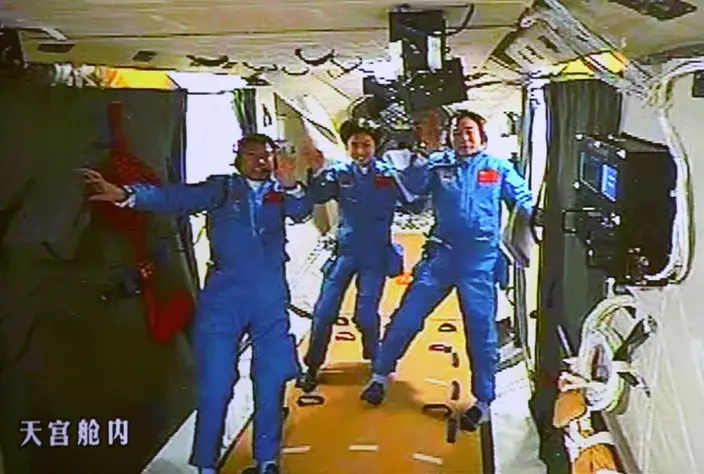
In this June 18, 2012, file image released by China's Xinhua News Agency, Chinese astronauts, from left, Liu Wang, Liu Yang and Jing Haipeng wave while aboard the orbiting Tiangong-1 space station. (Beijing Aerospace Control Center/Xinhua via AP)
Western space experts say they believe China has lost control of the station. China's chief space laboratory designer Zhu Zongpeng has denied Tiangong was out of control, but hasn't provided specifics on what, if anything, China is doing to guide the craft's re-entry.
Based on Tiangong 1's orbit, it will come to Earth somewhere between latitudes of 43 degrees north and 43 degrees south, or roughly somewhere over most of the United States, China, Africa, southern Europe, Australia and South America. Out of range are Russia, Canada and northern Europe.
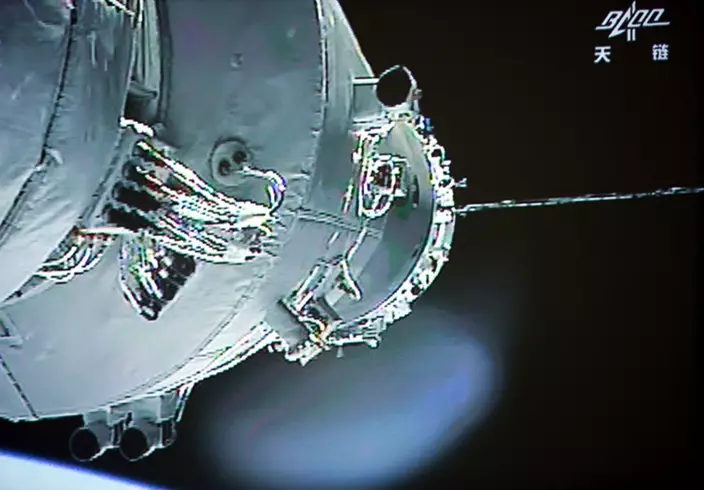
In this June 13, 2013, file image released by China's Xinhua News Agency, the Shenzhou-10 manned spacecraft is seen while conducting docking with the orbiting Tiangong-1 space module. (Beijing Aerospace Control Center/Xinhua via AP, File)
Based on its size, only about 10 percent of the spacecraft will likely survive being burned up on re-entry, mainly its heavier components such as its engines. The chances of anyone person on Earth being hit by debris is considered less than one in a trillion.
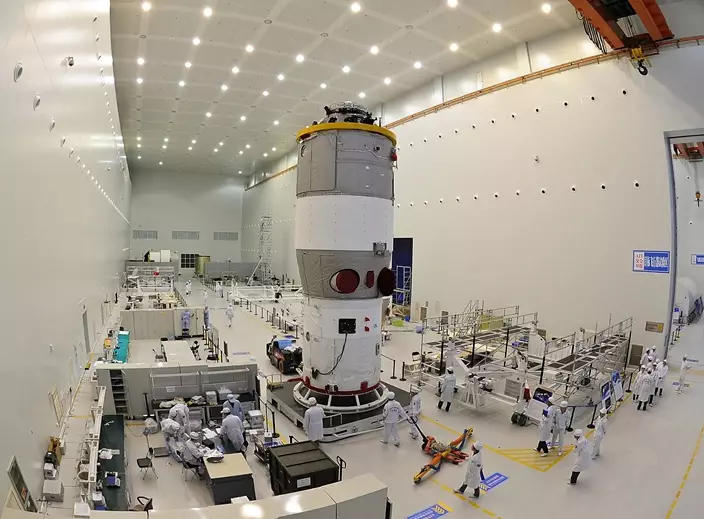
This undated file photo shows researchers testing China's first space station module Tiangong-1 at the Jiuquan Satellite Launch Center in northwest China's Gansu Province prior to its launch on Sept. 29, 2011. (Color China Photo via AP, File)
Ren Guoqiang, China's defense ministry spokesman, told reporters Thursday that Beijing has been briefing the United Nations and the international community about Tiangong 1's re-entry through multiple channels.
___
HOW COMMON IS MAN-MADE SPACE DEBRIS?
Debris from satellites, space launches and the International Space Station enters the atmosphere every few months, but only one person is known to have been hit by any of it: American woman Lottie Williams, who was struck but not injured by a falling piece of a U.S. Delta II rocket while exercising in an Oklahoma park in 1997.
Most famously, America's 77-ton Skylab crashed through the atmosphere in 1979, spreading pieces of wreckage near the southwestern Australia city of Perth, which fined the U.S. $400 for littering.

This undated file photo shows researchers installing China's first space station module Tiangong-1 at the Jiuquan Satellite Launch Center in northwest China's Gansu Province prior to its launch on Sept. 29, 2011. (Color China Photo via AP, File)
The breakup on re-entry of the Columbia space shuttle in 2003 killed all seven astronauts and sent more than 80,000 pieces of debris raining down on a large swath of the Southern United States. No one on the ground was injured.
In 2011, NASA's Upper Atmosphere Research Satellite was considered to pose a slight risk to the public when it came down to Earth 20 years after its launching. Debris from the 6-ton satellite ended up falling into the Pacific Ocean, causing no damage.
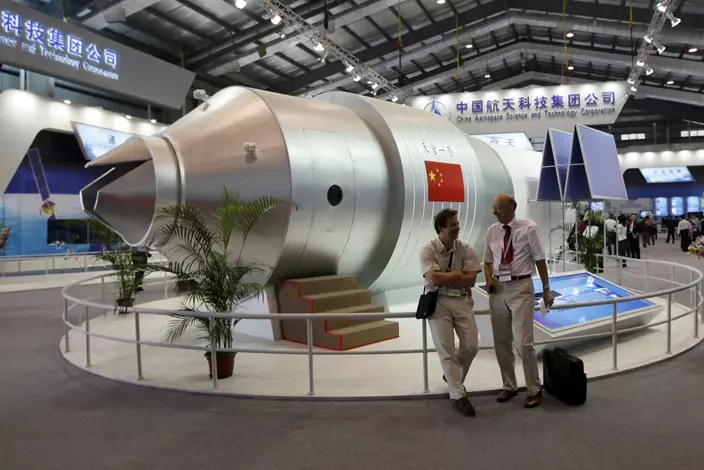
In this Nov. 16, 2010 file photo, visitors sit beside a model of China's Tiangong-1 space station at the 8th China International Aviation and Aerospace Exhibition in Zhuhai in southern China's Guangdong Province. (AP Photo/Kin Cheung, File)
China's own space program raised major concerns after it used a missile to destroy an out-of-service Chinese satellite in 2007, creating a large and potentially dangerous cloud of debris.
___
WHAT IS TIANGONG 1 AND WHAT WAS IT USED FOR?
Launched in 2011, Tiangong 1 was China's first space station, serving as an experimental platform for bigger projects such as the Tiangong 2 launched in September 2016 and a future permanent Chinese space station.
The station, whose name translates as "Heavenly Palace," played host to two crewed missions that included China's first female astronauts and served as a test platform for perfecting docking procedures and other operations. Its last crew departed in 2013 and contact with it was cut in 2016. Since then it has been orbiting gradually closer and closer to Earth on its own while being monitored.
The station had two modules, one for its solar panels and engines, and one for a pair of astronauts to live in and conduct experiments. A third astronaut slept in the Shenzhou spaceships that docked with the station, which also contained facilities for personal hygiene and food preparation.
___
HOW ADVANCED IS CHINA'S SPACE PROGRAM?
Since China conducted its first crewed mission in 2003 — becoming only the third country after Russia and the U.S. to do so — it has taken on increasingly ambitious projects, including staging a spacewalk and landing its Jade Rabbit rover on the moon.
China now operates the Tiangong 2 precursor space station facility, while the permanent station's 20-ton core module is due to be launched this year. The completed 60-ton station is set to come into full service in 2022 and operate for at least a decade.
China was excluded from the 420-ton International Space Station mainly due to U.S. legislation barring such cooperation and concerns over the Chinese space program's strong military connections. China's space program remains highly secretive and some experts have complained that a lack of information about Tiangong 1's design has made it harder to predict what might happen upon its re-entry.
A mission to land another rover on Mars and bring back samples is set to launch in 2020. China also plans to become the first country to soft-land a probe on the far side of the moon.
SHANGHAI (AP) — U.S. Secretary of State Antony Blinken raised what the U.S. describes as unfair Chinese trade practices during his first full day of meetings in China on Thursday with local government officials in the financial hub of Shanghai.
Blinken met with the city's top official, Communist Party Secretary Chen Jining, and “raised concerns about (Chinese) trade policies and non-market economic practices," the State Department said in a statement.
It said he stressed that the United States seeks healthy economic competition with China and "a level playing field for U.S. workers and firms operating in China.”
“The two sides reaffirmed the importance of ties between the people of the United States and (China), including the expansion of exchanges between students, scholars, and business,” it said.
China's multibillion-dollar trade surplus with the U.S. along with accusations of intellectual property theft and other practices seen as discriminating against U.S. businesses in China have long been a source of friction in relations.
China, for its part, has objected strongly to U.S. accusations of human rights abuses and Washington's support for Taiwan, the self-governing island that Beijing considers its own territory and warns could be annexed by force.
Asked about Blinken's comments, Chinese Foreign Ministry spokesperson Wang Wenbin said China has “always conducted economic and trade cooperation in accordance with market principles, firmly supported the multilateral trading system, and fully complied with the rules of the World Trade Organization.”
“We hope the U.S. will also earnestly respect the principle of fair competition, abide by the WTO rules, and work with China to create favorable conditions for the sound and stable development of China-U.S. economic and trade relations,” Wang told reporters at a daily briefing.
Blinken also spoke with students and business leaders before flying to Beijing for what are expected to be contentious talks with national officials, including Foreign Minister Wang Yi and possibly President Xi Jinping.
Blinken arrived in Shanghai on Wednesday shortly before U.S. President Joe Biden signed a $95 billion foreign aid package that has several elements likely to anger Beijing, including $8 billion to counter China’s growing aggressiveness toward Taiwan and in the South China Sea. It also seeks to force TikTok’s China-based parent company to sell the social media platform.
China has railed against U.S. assistance to Taiwan and immediately condemned the aid as a dangerous provocation. It also strongly opposes efforts to force TikTok’s sale.
Still, the fact that Blinken made the trip — shortly after a conversation between Biden and Xi, a visit to China by Treasury Secretary Janet Yellen and a call between the U.S. and Chinese defense chiefs — is a sign the two sides are at least willing to discuss their differences.
“I think it’s important to underscore the value — in fact, the necessity — of direct engagement, of speaking to each other, laying out our differences, which are real, seeking to work through them,” Blinken told Chen, according to the State Department statement.
“We have an obligation for our people, indeed an obligation to the world, to manage the relationship between our two countries responsibly,” he said. “That is the obligation we have, and one that we take very seriously.”
Chen agreed with that sentiment and said the recent Biden-Xi call had helped the “stable and healthy development of our two countries’ relationship.”
“Whether we choose cooperation or confrontation affects the well-being of both peoples, both countries, and the future of humanity,” he said.
Chen added that he hoped Blinken was able to get a “deep impression and understanding” of Shanghai, a city of skyscrapers, ports and more than 25 million people that is a magnet for commercially ambitious young people from China and abroad.
Most recently, the U.S. has raised concerns that potential overcapacity in Chinese industries — such as electric vehicles, steel and solar panels — might crowd out U.S. and other foreign manufacturers.
Shortly after arriving, Blinken attended a Chinese basketball playoff game between the local Shanghai Sharks and the Zhejiang Golden Bulls, with the home team losing in the last seconds in a 121-120 nailbiter.
With the U.S. presidential race heating up, it’s unclear what ramifications a victory for either Biden or former President Donald Trump might have for relations. But Trump could deepen a trade war he started during his first term. His tough rhetoric on China and isolationist approach to foreign policy could ramp up uncertainties.

U.S. Secretary of State Antony Blinken, center, with NYU Shanghai Vice Chancellor Jeffrey Lehman, back right, talks to students at NYU Shanghai, Thursday, April 25, 2024, in Shanghai, China. (AP Photo/Mark Schiefelbein, Pool)
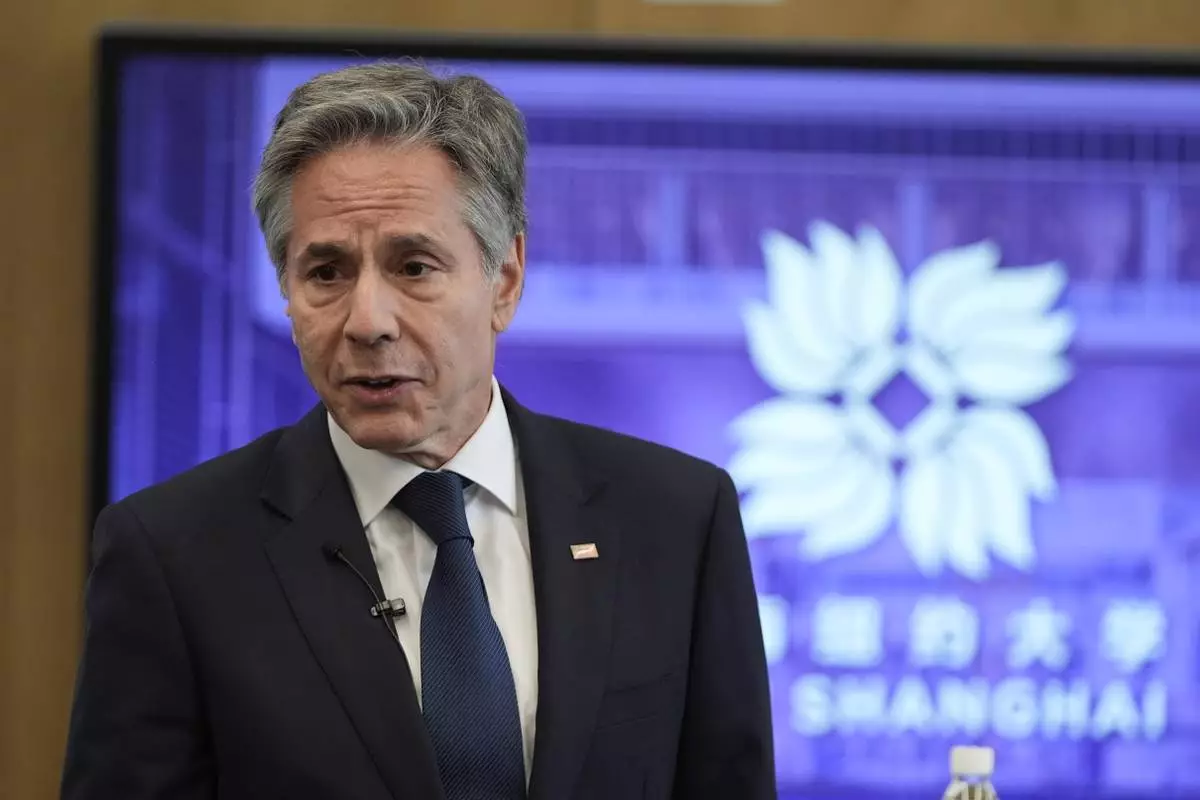
U.S. Secretary of State Antony Blinken talks to students at NYU Shanghai, Thursday, April 25, 2024, in Shanghai, China. (AP Photo/Mark Schiefelbein, Pool)
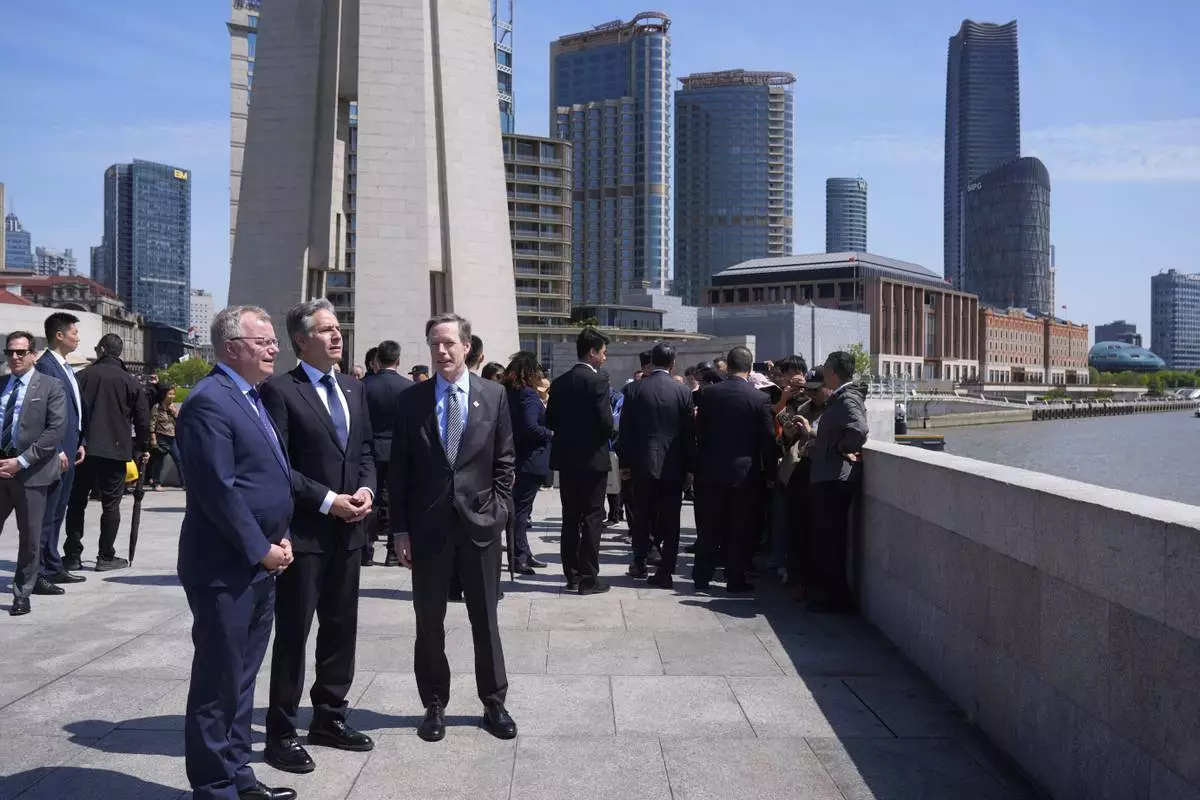
U.S. Secretary of State Antony Blinken, second left, U.S. Ambassador to China Nicholas Burns, third left, and Scott Walker, left, Consul General at the U.S Consulate General in Shanghai, visit a waterfront area called The Bund, Thursday, April 25, 2024, in Shanghai, China. (AP Photo/Mark Schiefelbein, Pool)
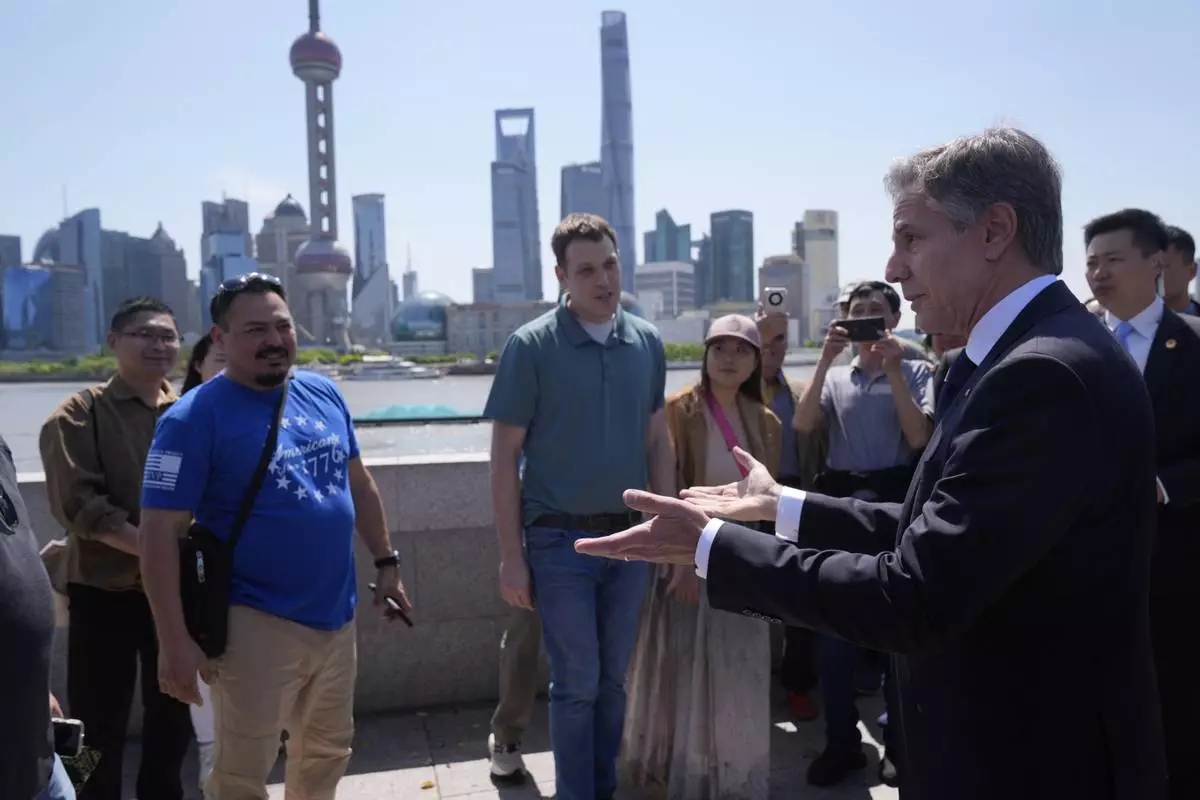
U.S. Secretary of State Antony Blinken, right, talks with U.S. tourists as he walks in a waterfront area called The Bund, Thursday, April 25, 2024, in Shanghai, China. (AP Photo/Mark Schiefelbein, Pool)

U.S. Secretary of State Antony Blinken talks with U.S. Ambassador to China Nicholas Burns, center, with U.S. Consulate General in Shanghai Scott Walker, left, while attending a basketball game between the Shanghai Sharks and the Zhejiang Golden Bulls at the Shanghai Indoor Stadium, Wednesday, April 24, 2024, in Shanghai, China. (AP Photo/Mark Schiefelbein, Pool)

U.S. Secretary of State Antony Blinken talks with U.S. Ambassador to China Nicholas Burns, center, with U.S. Consulate General in Shanghai Scott Walker, right, while attending a basketball game between the Shanghai Sharks and the Zhejiang Golden Bulls at the Shanghai Indoor Stadium, Wednesday, April 24, 2024, in Shanghai, China. (AP Photo/Mark Schiefelbein, Pool)

U.S. Secretary of State Antony Blinken, second left, and U.S. Ambassador to China Nicholas Burns, far right, arrive at the Grand Halls to meet with Shanghai Party Secretary Chen Jining on Thursday, April 25, 2024, in Shanghai, China. (AP Photo/Mark Schiefelbein, Pool)

U.S. Secretary of State Antony Blinken, left, shakes hans with Shanghai Party Secretary Chen Jining as they meet at the Grand Halls, Thursday, April 25, 2024, in Shanghai, China. (AP Photo/Mark Schiefelbein, Pool)
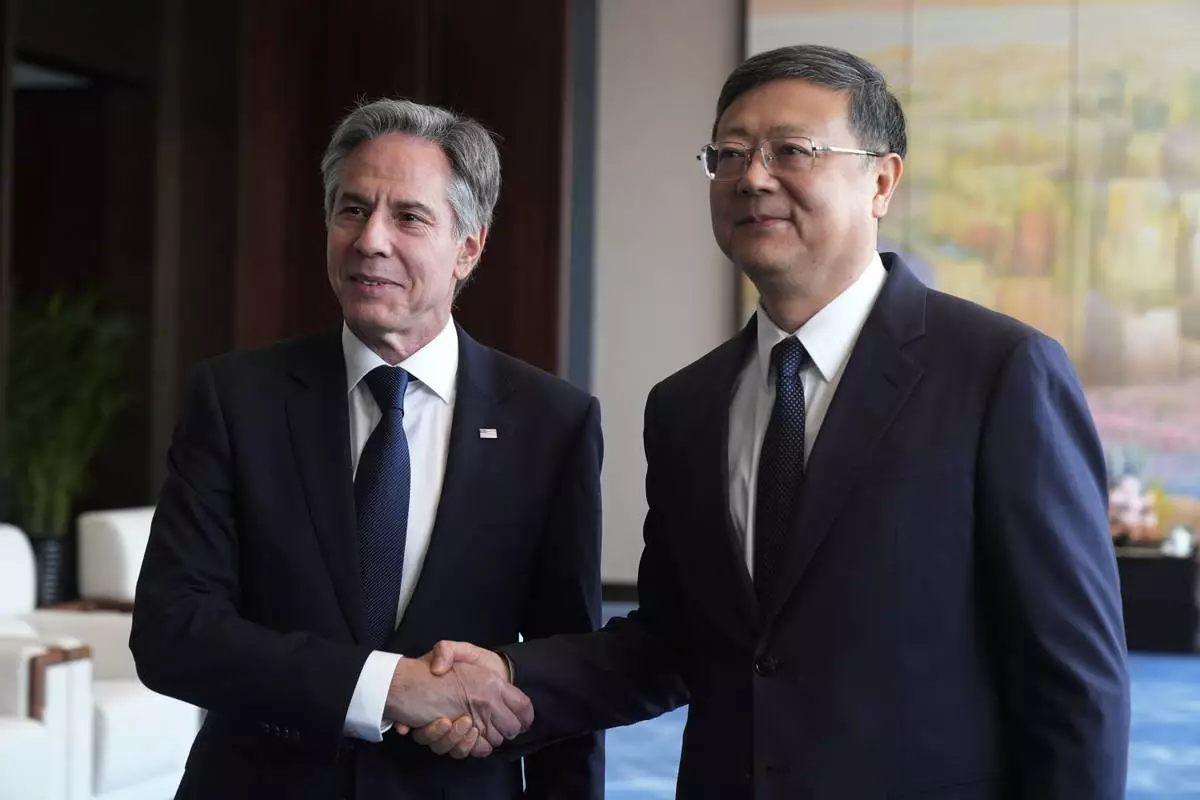
U.S. Secretary of State Antony Blinken, left, meets with Shanghai Party Secretary Chen Jining at the Grand Halls, Thursday, April 25, 2024, in Shanghai, China. (AP Photo/Mark Schiefelbein, Pool)
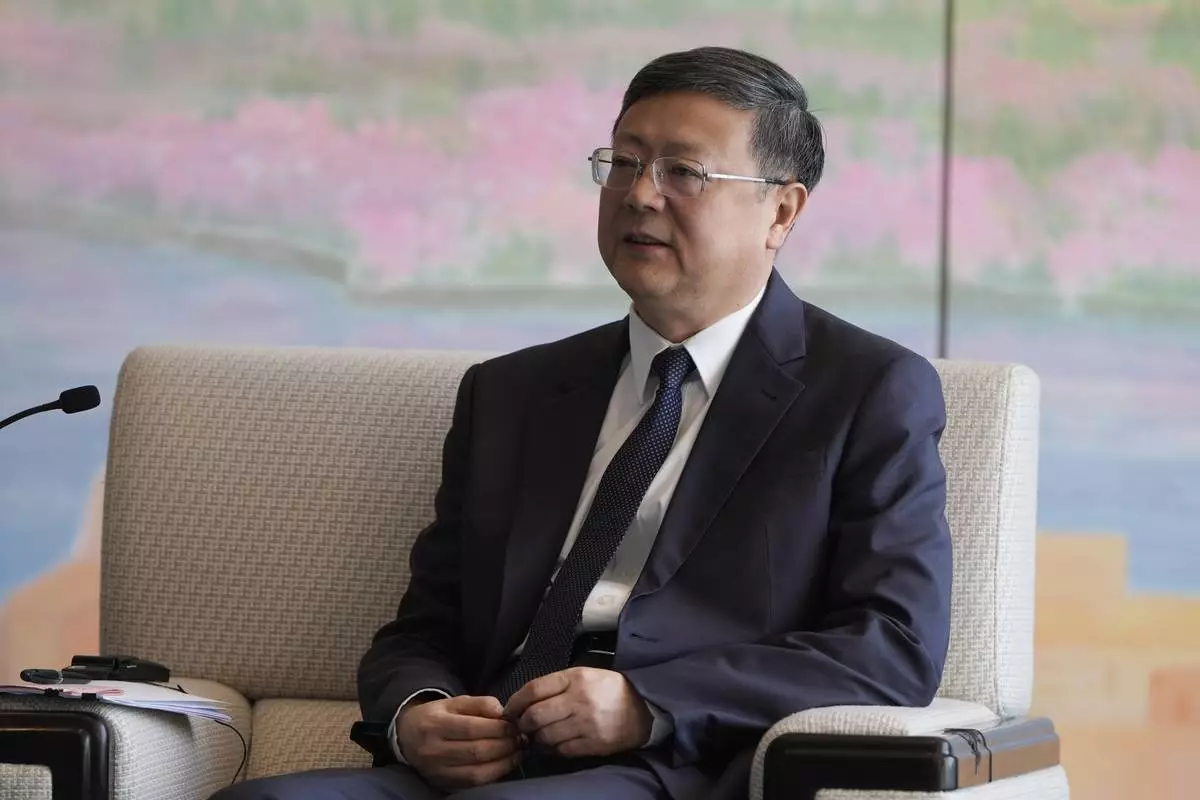
Shanghai Party Secretary Chen Jining talks with U.S. Secretary of State Antony Blinken at the Grand Halls, Thursday, April 25, 2024, in Shanghai, China. (AP Photo/Mark Schiefelbein, Pool)
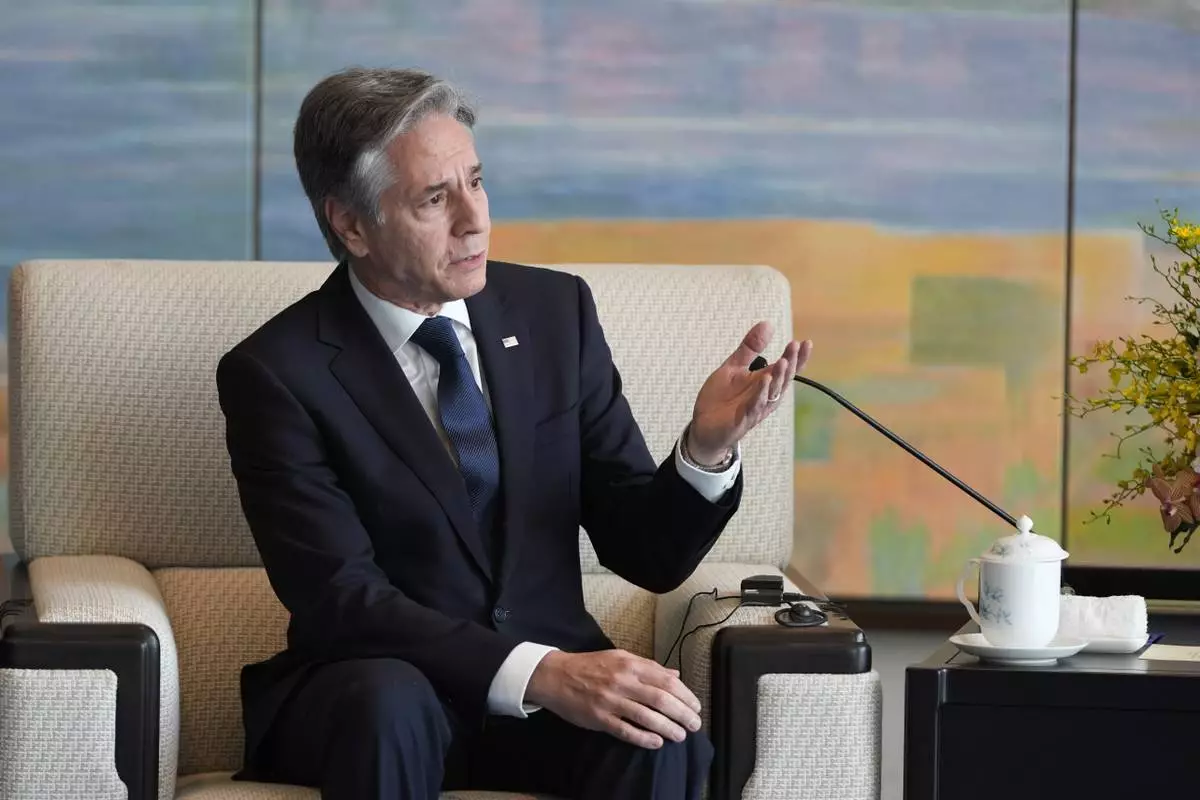
U.S. Secretary of State Antony Blinken talks with Shanghai Party Secretary Chen Jining at the Grand Halls, Thursday, April 25, 2024, in Shanghai, China. (AP Photo/Mark Schiefelbein, Pool)
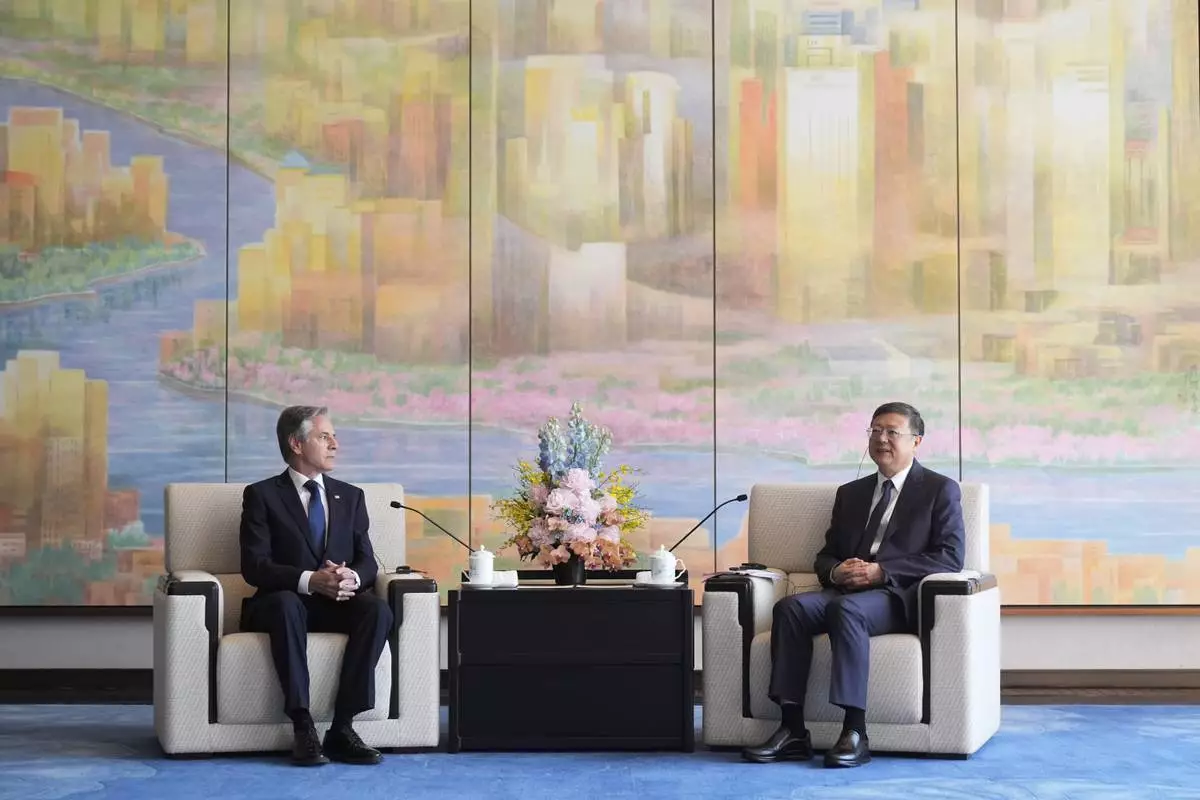
U.S. Secretary of State Antony Blinken, left, talks with Shanghai Party Secretary Chen Jining at the Grand Halls, Thursday, April 25, 2024, in Shanghai, China. (AP Photo/Mark Schiefelbein, Pool)
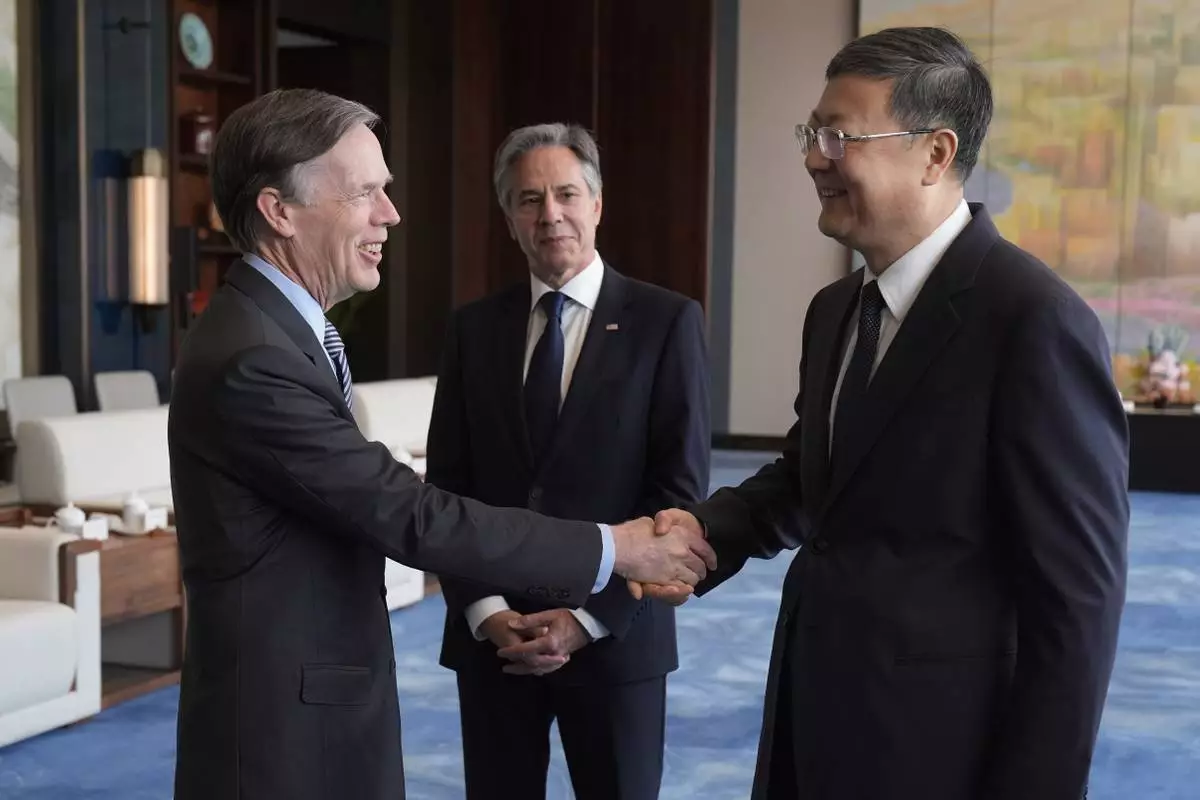
U.S. Secretary of State Antony Blinken, center, watches U.S. Ambassador to China Nicholas Burns, left, shake hands with Shanghai Party Secretary Chen Jining at the Grand Halls, Thursday, April 25, 2024, in Shanghai, China. (AP Photo/Mark Schiefelbein, Pool)

























